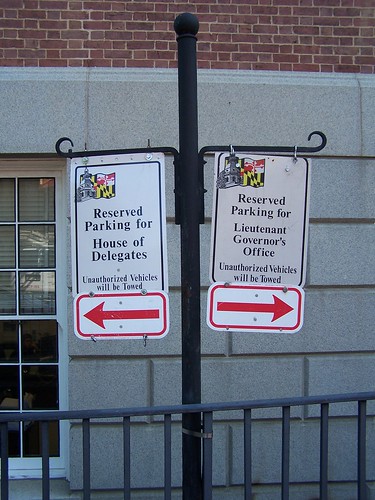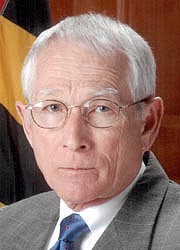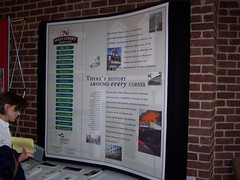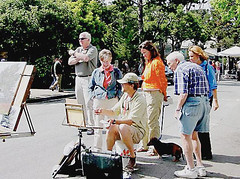Main Street and getting schooled in politics, constituency building, and building support for your program
 Learning about politics from the State of Maryland.
Learning about politics from the State of Maryland.I think I wrote in March about Jim Diers and the Department of Neighborhoods in Seattle. His book, Neighbor Power: Building Community the Seattle Way, is about the various neighborhood-based planning and capacity building efforts in that city during his tenure as the director of the office. The current mayor decided not to keep him on, and the last chapter discusses a bit his surprise about this, given the success of the various programs.
My sense about this when reading the book, is that they (he) didn't expend energy on developing meta-support for the program. And that the various efforts in the neighborhoods were great for the individual neighborhood, but didn't build capacity in a city-wide sense.
This is important because it is so clear that the same thing happened in DC with the Main Street program. I don't know if this is because DC is unique, that people like to eat their young, are incredibly negative and parochial, or what. I do think in any case, people are short-sighted. As I say time and time again, there is a reason why many neighborhoods in the city have been troubled for a long long time.
I participated in a program review exercise for the DC Main Streets program about a year ago, and most of the people were very negative about various staff, etc. They probably just wanted to get the money from DC Main Streets and leave it at that.
But that sure didn't build a constituency for lobbying and building support for the program in a substantive way. Now the program faces an uncertain future as Mayor Williams leaves office, and as a "new" revitalization program, "Great Streets" takes center stage. (Although already this program seems to have some problems vis-a-vis support from City Council, see this article by Sean Madigan from the Washington Business Journal, "DC Council pulls back $10M from Great Streets" for more about that.)
Since urban renewal days, every 3-4 years, it appears as if the DC government has introduced a new revitalization program of one sort or another. If you go back and look at Washington Post coverage of H Street for the years 1979-1987, you can really see this. Merchants on the corridor pictured in an article from 1984 are present on the corridor today, still waiting for the promise of revitalization to come true.
In retrospect, I can understand why they were polite to people like me, coming into their businesses, talking about the opportunity and likelihood of revitalization, but they held back from really committing themselves or getting involved. They truly had seen it all before....
The Main Street program in the city was given a bit of money and some support, but hasn't had the chance to burrow in and build. And given the level of disinvestment most neighborhood commercial districts have experienced over the decades, it was pretty naive to expect that a bunch of volunteers, with almost no money for programming, could miraculously turn around these commercial districts in a couple years, after decades of failed DC Government attempts to do the same.
Even so, two things at the Preservation Maryland conference convinced me about the importance of constituency building in politics. It's not like I don't know know this to be true, but I find the politics and palavering part of community development to be somewhat distasteful. I am into ideas, and implementation, best practices, model building, analysis, etc. I am not into the cocktail parties and receptions (although I do enjoy door knocking and the like, even though it is time consuming).
1. Anyway, the Coalition of Maryland Heritage Areas has a breakfast at the PM conference, and this year there was a keynote speaker, Sen. John Astle of Maryland. He represents Anne Arundel County, lives in the Annapolis historic district, and among his duties serves on the Senate Finance Committee and on the State Tourism Development Board.
 Senator John Astle, Maryland.
Senator John Astle, Maryland.He spoke about how to interact with public officials, how he didn't know much of anything about tourism to begin with, but how the director of the Annapolis Convention and Visitors Bureau cultivated him, and how this began the process of Sen. Astle learning about the importance of tourism (and historic preservation) and how he came to be a strong advocate for the state's cultural heritage.
For example, for every dollar the State of Maryland spends on heritage areas, they have documented an annual return of $4.61--meaning that one dollar spent 10 years ago when the program was first created has returned over $40 back to the state and local governments in terms of tax and other revenues.
Sen. Astle had some good advice for how to engage elected officials and build awareness and support for your program(s). I'm not going to write it all out for you, but in any case it was practical, focused advice. And I know that few Main Street programs in DC have done a very good job communicating with their local councilmember or the at-large councilpeople.
One of the things Sen. Astle said is important--don't invite a bunch of politicians to an event, because it's easy for them to say no, figuring someone else will still attend, but when you build an event around one person, they really can't refuse you.
2. On Friday, there was a luncheon and awards presentation for Main Street Maryland programs. Oddly enough, the City of Baltimore Main Street program doesn't appear to be considered part of the State of Maryland Main Street program, eligible for state funding, etc., although some people from the Baltimore programs attended the lunch.
 Main Street Maryland promotional display, Preservation Maryland annual conference, Annapolis, May 18-19, 2006.
Main Street Maryland promotional display, Preservation Maryland annual conference, Annapolis, May 18-19, 2006.The state program had apparently downshifted for awhile but is gearing back up. I am certain this is because it is an election year, and Gov. Ehrlich is looking for support from the 18 communities that have state-designated Main Street programs. For example, at the meeting it was announced that the state had come up with a few hundred thousand dollars for Main Street programs, with applications to be made available shortly, with a due date of 6/30. My immediate reaction was "Can you say electioneering?"
Even so, this luncheon was important for building support for the Main Street program at the state level, regardless of who is in office. They gave out many awards (I don't have the materials with me at the moment) in three categories: volunteer of the year (3 awards, nominated by the programs), bricks and mortar-business development (maybe 6-8 awards), and for special events, programs, and materials, such as the award-winning Easton Plein Air Competition and Arts Festival.
 Plein air painting in Easton, Maryland.
Plein air painting in Easton, Maryland.In the second year of the DC Main Streets program, there was a reception at the City Museum, but such an event was never repeated.
THAT WAS A MISTAKE.
To build capacity and support, DC Main Streets should have (and still could) develop an annual one day conference including an awards luncheon.
If you don't work to consciously build your own base and constituency, it's hard to get anyone to support you. Ask Jim Diers... you couldn't ask for a more successful neighborhood-based planning and capacity building program than his, and yet, when officeholders changed, he had to go...
(Some of this thinking will get incorporated into stuff I am working on about marketing public services, especially transit.)
Index Keywords: constituency-building



0 Comments:
Post a Comment
<< Home